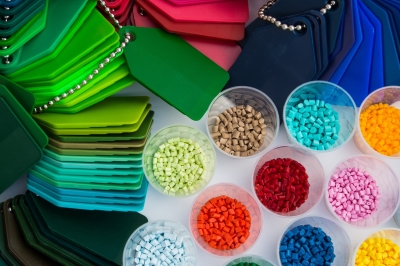Understanding Colour Variation and How It Occurs
08/06/17

By Tony Bestall, Director of Silvergate Plastics
Colour is subjective and has a huge impact on our physiology and psychology, so getting the right colour for your product is essential to widening its appeal, increasing perceived value and retaining the integrity of your brand.
The human eye cannot be relied upon to judge colour accuracy. We all see colour differently, even when we’re looking at the same object! When it comes to colouring plastics, it’s important to use a variety of methods to manage colour accuracy, especially when matching physical samples. Luckily for our customers, we have invested in a highly effective system for measuring colour precisely, which includes the use of a spectrophotometer and various light environments.
The spectrophotometer can measure the colour of a physical sample and also be used to check the accuracy of a colour match. Not only does it identify precise colour coordinates on a spectrum of over twenty million colours but it can store specific references and data, including industry standard RAL and Pantone references. More colour references can be added as they are created, thereby building a comprehensive library of accurate formulations or recipes from which to match a colour.
When creating a colour formulation, it is imperative that the masterbatch technician knows the environment in which the end product will be used. If, for example, a product is to be used in direct sunlight, then the appropriate light fast pigments must be used to prevent discolouration.The use of a UV stabiliser will not protect pigments and subsequently they can change colour!
There is a common misconception that if a stable, robust manufacturing process is utilised in colourant manufacture, using the same raw materials in the same ratios, the same colour will be produced every time. Practically, this is not true.
The pigments used to manufacture masterbatches are all bought to a specification regarding colour. That specification is commonly the same used for masterbatches. The colour difference between each batch of pigment and the ‘standard’ is described as ‘Delta E’. This is a single number used to communicate colour difference. The industry standard ‘pass or fail’ criteria is a Delta E of 1, and visually this difference is usually accepted as a good match to the human eye.
When producing a specific colour masterbatch, each pigment will be purchased to an agreed colour difference and will potentially vary up to a maximum of 1. If a colour is comprised of several pigments, the resulting masterbatch produced can be different from the masterbatch standard, as the small variances in each pigment can be cumulative. Consequently, masterbatch producers commonly tweak off-shade materials by adjusting the colour back into specification.
Of course, there are processing errors that can occur along the way once a masterbatch has been supplied. When the masterbatch is approved for sale, post quality control, it will be within specification and supplied at a recommended ‘use at percentage’ that will exhibit a colour that is very close to the original standard. If the use at percentage (by weight) is different from that recommended, for any reason, the colour of the moulded component will be wrong.
If the processor has dosed the masterbatch according to the agreed Let Down Rate and the colour is variable, the likely root cause will be poor distribution. The term distribution describes the homogenisation or mixing process between the masterbatch and host polymer. If the two are not mixed sufficiently, colour variation and streaking will inevitably occur. This is also true if there is a static build up within the processing equipment, as the masterbatch sticks to the side of the machine hopper rather than flowing consistently into the host polymer.
By following strict quality controls, including such practices as retaining a master plaque, colour variation can be minimised. Once the colour has been verified, it is up to the processor to ensure the masterbatch is dosed accurately and mixed sufficiently to achieve the desired colour strength. Good quality masterbatch manufacturers ought to be able to discuss such colour variation challenges with plastics processors so unnecessary complications and delays within their manufacturing processes can be avoided.

More free stuff!
Receive your Free Guide to Colouring Plastics when you sign up for our newsletter! We will only ever send exciting news that you’ll want to read, so what are you waiting for?
Sign me up to be the first to read about Silvergate’s product launches, innovations and news! We will never share your information with third parties.








